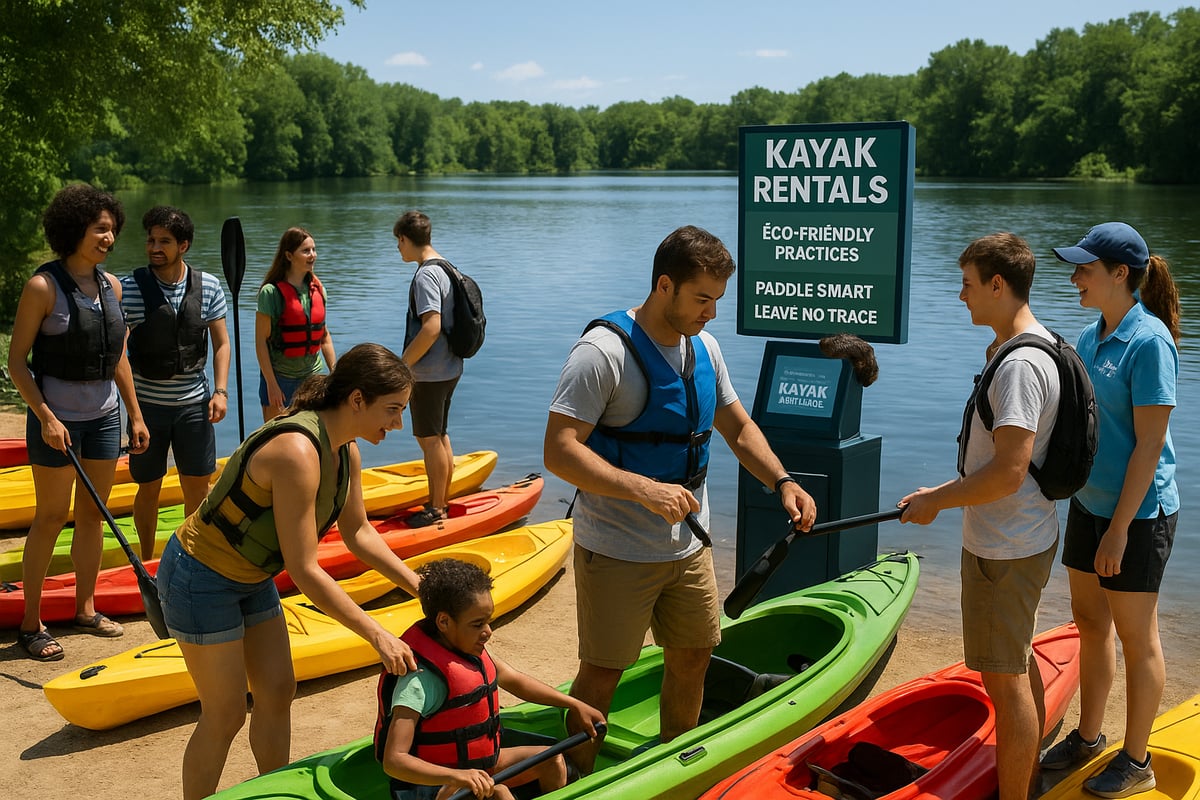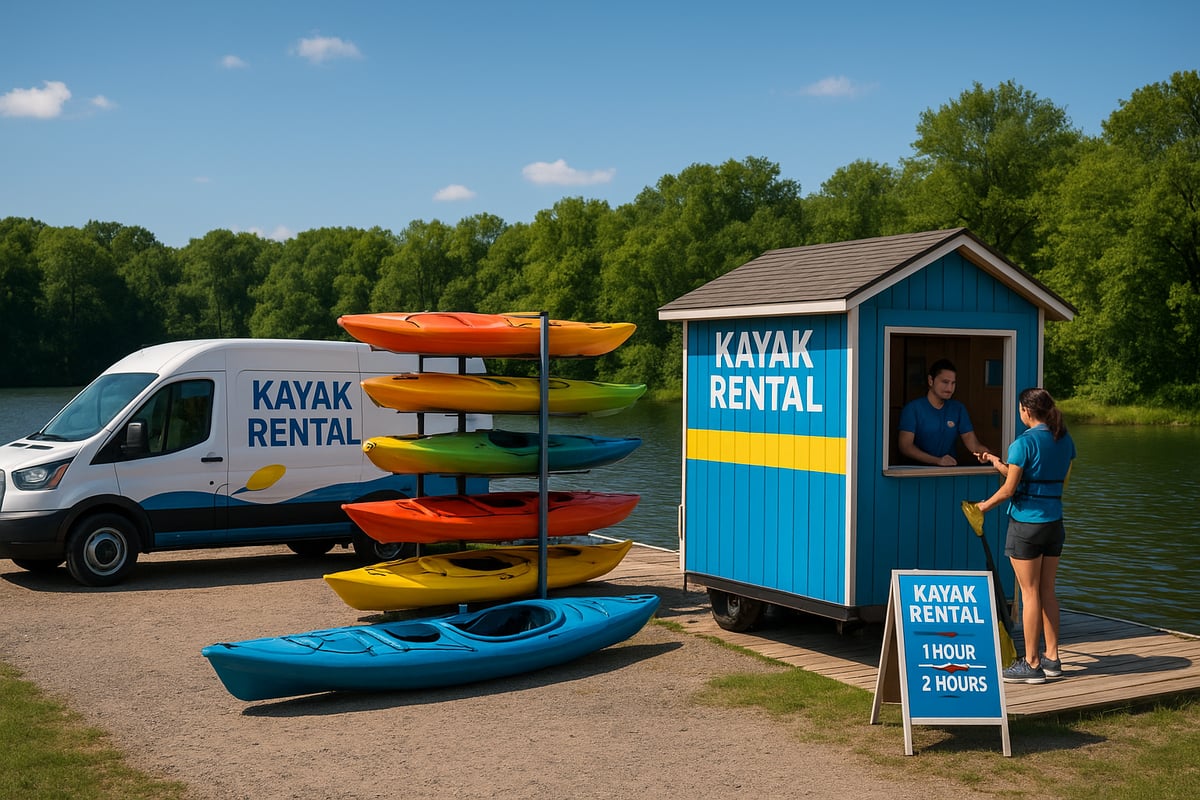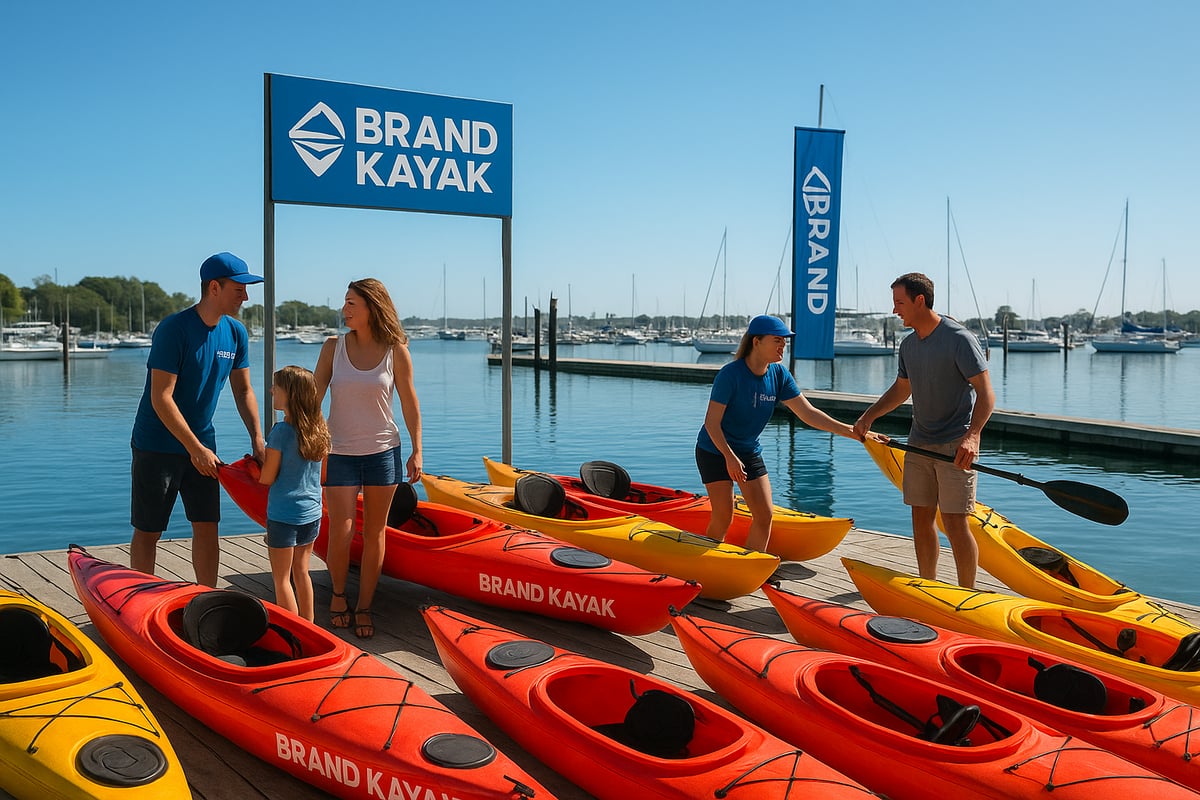Picture this: your kayak rental business is booked up, every weekend, all season long. The outdoor recreation boom is real, and the marine industry is riding its wave into 2025.
If you’ve ever wondered how to build a kayak rental business model that stands out, this guide is for you. We’ll break down market trends, business strategies, operations, marketing, and profit tactics—all designed for marine entrepreneurs who want results.
The potential is huge, and the right steps can turn your dream into a thriving operation. Ready for a blueprint that works? Let’s dive in.
Understanding the 2025 Kayak Rental Market
The kayak rental business model is riding a wave of transformation as we head into 2025. Outdoor recreation has exploded since 2020, with kayaking at the forefront. Entrepreneurs in the marine industry need to grasp the latest trends, customer shifts, and technology influences to stay ahead.

Market Growth & Trends
The outdoor recreation industry has seen record growth, and kayaking continues to shine as one of the fastest-growing activities. Post-pandemic, more Americans are seeking local adventures and unique experiences on the water. The kayak rental business model benefits directly from this trend, with the U.S. market projected to reach nearly $600 million by 2025, and a compound annual growth rate (CAGR) hovering around 6%.
Seasonal demand still dominates most regions, especially in colder climates. Coastal towns, lakeside communities, and riverfront cities experience spikes during spring and summer. However, some operators in warmer states are now pushing for year-round bookings by expanding offerings and targeting winter travelers.
Demographics are shifting too. Millennials and Gen Z make up a growing portion of renters, often seeking eco-friendly adventures and share-worthy experiences. Families are also embracing kayaking for its accessibility and group appeal. Sustainability matters more than ever, with customers gravitating toward businesses that use recycled materials, minimize single-use plastics, and promote environmental stewardship.
Competition is heating up. Local operators, national chains, and even peer-to-peer kayak rental business model platforms are all vying for market share. The rise of online booking, mobile apps, and digital waivers has set new customer expectations for speed and convenience. For detailed market projections and regional insights, review the latest Kayak Rental Market Research Report 2033.
Customer Segments & Preferences
To build a resilient kayak rental business model, you need to know your customers inside and out. The main personas include tourists looking for guided tours, locals seeking quick getaways, adventure seekers craving remote routes, and families wanting safe, fun outings.
Preferences are evolving fast. Guided rentals and lessons are popular with first-timers and visitors, while experienced paddlers lean toward self-guided options and flexible time slots. Group packages, special events, and add-on services like waterproof bags or snacks can boost satisfaction and revenue.
Accessibility and inclusivity are now baseline expectations. Adaptive kayaks open up the sport to people with disabilities. Family-friendly equipment and clear safety protocols reassure parents and guardians.
Booking behavior has shifted dramatically. Most customers now prefer online reservations, especially for planning ahead, but walk-up and last-minute bookings still play a role—especially during peak season. Social proof is powerful. Reviews on Google, TripAdvisor, and social media often make or break a decision, so delivering a top-tier experience is non-negotiable for the kayak rental business model.
Choosing the Right Kayak Rental Business Model
Selecting the right kayak rental business model is the foundation for long-term success in the marine industry. Your decision shapes everything, from startup costs to how you attract customers and scale. With shifting travel habits and evolving consumer expectations in 2025, understanding each model's nuances is crucial for marine entrepreneurs.

Business Model Types
There’s no one-size-fits-all kayak rental business model—each approach has its pros, cons, and operational quirks. Here’s a breakdown of the major options:
- Brick-and-Mortar Rental Shop: This classic model offers a fixed storefront or boathouse at a prime waterfront location. It’s reliable for consistent foot traffic, but comes with higher rent, staffing, and insurance costs. Great for high-volume tourist zones.
- Mobile/Van-Based Rentals: A flexible kayak rental business model, perfect for reaching multiple launch sites or underserved areas. You’ll need to handle transport logistics and local parking rules, but upfront costs are usually lower.
- Dockside or Marina Partnerships: By teaming up with existing marinas, you tap into their customer base and infrastructure. This model reduces your setup hassle, though you may pay revenue shares or face limited branding.
- Peer-to-Peer Kayak Sharing Platforms: Think of this as the Airbnb of kayaking. You list your fleet on an app, manage bookings remotely, and split profits with the platform. It’s low-overhead, but you’ll need to navigate legal and insurance requirements.
- Hybrid Models: Many successful operators blend multiple approaches—like a main shop plus mobile pop-ups—to maximize reach.
For a deeper dive into actionable strategies and insights that can strengthen any kayak rental business model, check out Boat rental business strategies.
The model you choose should align with your market, location, and goals. Local regulations, insurance, and target customers all play a role. Take time to map out which kayak rental business model fits your vision for growth.
Revenue Streams & Pricing
A profitable kayak rental business model goes way beyond hourly rentals. Diverse revenue streams and smart pricing keep cash flowing, even in slow seasons.
- Rental Pricing Structures: Most operators offer hourly, half-day, daily, or weekly rates. Dynamic pricing—adjusting rates for weekends or holidays—can boost margins.
- Guided Tours & Lessons: Add-ons like eco-tours or skill lessons attract adventure seekers and families. These services command premium rates and help differentiate your business.
- Memberships & Loyalty Programs: Regulars love perks. Offer seasonal passes or loyalty rewards to secure repeat business and smooth out revenue swings.
- Merchandise & Add-Ons: Branded dry bags, hats, sunscreen, or snacks can add up. These small-ticket items often have high markups and appeal to spontaneous buyers.
- Group Bookings & Partnerships: Corporate team-building, school trips, or local events can fill your schedule fast. Partner with hotels or tour operators for referral bookings.
| Revenue Stream | Typical Margin | Notes |
|---|---|---|
| Hourly Rentals | 60-75% | Core, high-turnover |
| Guided Tours | 50-65% | Higher labor, higher price |
| Merchandise Sales | 30-50% | Seasonal, high impulse |
| Group Bookings | 70-80% | Bulk, often off-peak |
According to industry reports, leading companies with a diversified kayak rental business model often see annual profit margins between 15% and 30%. The right mix of offerings allows you to target multiple customer segments and optimize for both peak and shoulder seasons.
Startup Costs & Financial Planning
Launching a kayak rental business model in the marine industry comes with unique financial realities. Here’s what to expect:
- Initial Investments: Budget for kayaks (new or used), paddles, life jackets, storage racks, and trailers. A modest fleet (10–15 kayaks) typically costs $15,000–$30,000. Don’t forget permits, branding, and digital booking tools.
- Ongoing Expenses: Maintenance, liability insurance, staff wages, and marketing are your main recurring costs. These can run $3,000–$7,000 per month, depending on your business size and rental model.
- ROI Timelines: Most operators recoup their upfront investment within 12–24 months, especially with a scalable kayak rental business model that leverages off-season activities or add-ons.
- Funding Options: Many marine entrepreneurs self-fund, but small business loans, grants, and even local tourism incentives are available. Research regional programs that support outdoor recreation startups.
Use clear financial projections to chart your break-even point and plan for reinvestment. A disciplined approach to cash flow and expense management is vital for any kayak rental business model aiming for sustainable growth.
Step-by-Step Guide to Launching a Kayak Rental Business
Launching a kayak rental business model in the marine industry requires more than just a passion for water sports. Success hinges on careful planning, compliance, and a keen understanding of your market. Let's break down the process, step by step, so you can build a resilient operation in 2025.

1. Market Research & Location Analysis
Your journey starts with research. A successful kayak rental business model begins where demand meets opportunity. Evaluate local water access points, like lakes, rivers, or coastal areas, and study foot traffic and regulations.
Analyze your competition. Are you entering a saturated space, or is there room to offer something unique? Use demographic tools and tourism data to spot trends. Look for gaps, such as lack of family-friendly services or adaptive kayaking options.
Identify peak seasons. In some regions, rentals thrive year-round, while others are strictly seasonal. For deeper insights and a practical checklist, consider reviewing this step-by-step guide for entrepreneurs looking to launch a kayak rental business. A data-driven foundation will shape your entire kayak rental business model.
2. Legal, Insurance, and Compliance
Every kayak rental business model must meet strict legal and safety requirements. Start by securing your business license and registering with local authorities. Research permits for waterway access and environmental impact, as marine operations often face additional scrutiny.
Insurance is non-negotiable. Obtain general liability, marine insurance, and coverage for your equipment. Draft comprehensive liability waivers, and make sure they're signed before every rental. Stay current with Coast Guard safety standards, including required life jackets and emergency protocols.
Create a compliance checklist:
- Business registration and tax ID
- Waterway permits
- Environmental and zoning approvals
- Insurance certificates
- Safety and training documentation
Staying compliant protects your kayak rental business model and builds trust with both regulators and customers.
3. Building Your Kayak Fleet & Infrastructure
The core of your kayak rental business model is, of course, your fleet. Select kayaks based on expected clientele: solo, tandem, fishing, or adaptive models for inclusivity. Balance quality and cost by sourcing from reputable brands, and weigh the pros and cons of new versus used equipment.
Think about storage. Secure racks, trailers, or lockable storage units keep your fleet safe and organized. Maintenance routines are essential. Set up a schedule for cleaning, repairs, and inspections to minimize downtime and maximize asset lifespan.
Here's a simple table for kayak types and uses:
| Kayak Type | Best For | Notes |
|---|---|---|
| Sit-on-top | Beginners, families | Easy entry/exit |
| Tandem | Couples, groups | Higher capacity |
| Fishing | Anglers | Extra accessories |
| Adaptive | Accessible needs | Custom features |
A well-planned infrastructure supports a scalable kayak rental business model.
4. Staffing & Training
Behind every strong kayak rental business model is a skilled, knowledgeable team. Start by hiring staff with a passion for customer service and outdoor recreation. You'll need guides, dock crew, and reservation specialists.
Training is critical. Cover water safety, emergency response, and local geography. Teach staff how to deliver memorable experiences, from basic paddling tips to sharing insider knowledge about local wildlife or scenic routes.
Adjust schedules for peak and off-peak periods. Cross-train employees to handle multiple roles, ensuring flexibility. This approach keeps your kayak rental business model efficient and responsive to changing demand.
5. Technology & Booking Systems
Modern customers expect seamless technology. Invest in an online reservation platform that syncs with real-time fleet availability. Your kayak rental business model should offer mobile payment solutions and digital liability waivers for convenience and compliance.
Look for systems that integrate with your accounting and marketing tools. Real-time tracking and inventory management help you monitor equipment and avoid double bookings.
Must-have features:
- User-friendly booking calendar
- Secure payment processing
- Automated confirmation emails
- Digital waiver collection
- Inventory and fleet tracking
The right tech stack streamlines operations and enhances your kayak rental business model’s reputation.
6. Launching Operations
When it's time to open, start with a soft launch. Invite friends, family, and local influencers to test your services and provide feedback. Use this trial phase to refine your kayak rental business model, fix any workflow issues, and train your team under real conditions.
Promote early success stories through reviews and social media. Adjust your offerings based on demand and customer input. Stay agile, and be ready to tweak everything from pricing to tour options.
With a strategic launch and continuous improvement, your kayak rental business model will be set for long-term growth.
Marketing Your Kayak Rental Business for Maximum Bookings
Standing out in the marine industry means more than just having quality kayaks or a great location. The right marketing strategy can position your kayak rental business model for year-round demand and word-of-mouth buzz. Let’s break down proven tactics that help marine entrepreneurs attract, convert, and retain customers, even in crowded markets.

Branding & Positioning
A successful kayak rental business model starts with a memorable brand and a clear promise to customers. What makes your service different? Maybe it’s eco-friendly tours, local guides with insider knowledge, or all-inclusive adventure packages. Define your unique selling proposition (USP) early, and let it shape everything from your logo to your customer service standards.
Professional branding is more than just a good-looking logo. Invest in cohesive signage, a polished website, and staff uniforms that reinforce your commitment to quality. Consistent visual identity builds trust, especially in the marine industry where safety and reliability matter. Every touchpoint should echo your brand’s personality, whether you’re targeting families, thrill-seekers, or eco-conscious travelers.
Here’s a quick checklist for establishing a strong kayak rental business model brand:
| Branding Element | Why It Matters |
|---|---|
| Logo & Colors | Recognition and trust |
| Website | Booking convenience, first impressions |
| Uniforms/Signage | Professionalism, safety cues |
| Brand Voice | Connects with target audience |
A well-crafted brand positions your kayak rental business model as the go-to choice in your local marine market.
Digital Marketing Strategies
To keep your kayak rental business model booked solid, you need a digital presence that reaches customers where they search and scroll. Local SEO is essential—claim your Google Business Profile, update marine directory listings, and optimize for keywords that highlight your location and service. For a deeper dive, check out this Local SEO for marine businesses guide, which covers strategies tailored for the marine industry.
Content marketing works wonders, too. Publish blog posts, local waterway guides, and safety tips that answer common questions and attract organic traffic. Social media, especially Instagram and TikTok, lets you show off your fleet, happy customers, and scenic routes. Short videos, customer stories, and behind-the-scenes moments build engagement and trust.
Don’t forget paid advertising. Google Ads and Facebook campaigns can target both tourists planning ahead and locals looking for last-minute fun. The right blend of organic and paid digital tactics ensures your kayak rental business model shows up first—before your competitors.
Partnerships & Community Engagement
Growth in the kayak rental business model often comes from strategic partnerships and local connections. Team up with hotels, marinas, and tour operators to reach new customer segments. These businesses can refer guests directly or include your rentals in their activity packages.
Community engagement pays off, too. Participate in waterfront festivals, sponsor clean-up days, or host paddle events to raise your profile. The more visible you are, the more people associate your brand with local adventure and fun.
Referral networks are a hidden gem. Offer incentives for local businesses or satisfied customers who send new clients your way. This approach leverages trust and word-of-mouth, which is especially powerful in the marine sector. Smart partnerships turn your kayak rental business model into a recognized, respected part of the community.
Reputation Management & Customer Retention
Online reviews make or break your kayak rental business model. Encourage every customer to leave feedback on Google, TripAdvisor, and Yelp. Respond to all reviews, positive or negative, with professionalism and genuine care. Addressing concerns quickly shows you value safety, service, and satisfaction.
Loyalty programs and follow-up emails help turn one-time renters into repeat customers. Offer discounts for return visits, special deals for groups, or early-bird booking perks. Stay in touch with past guests through email newsletters—share weather updates, new tour routes, or seasonal events.
Here’s a simple retention strategy table:
| Retention Tactic | Impact |
|---|---|
| Loyalty Program | Repeat bookings |
| Email Campaigns | Ongoing engagement |
| Review Requests | Social proof, trust |
| Fast Feedback Response | Improved reputation |
A disciplined approach to reputation and retention ensures your kayak rental business model not only attracts new clients but keeps them coming back.
Optimizing Operations and Scaling Profitably
Running a successful kayak rental business model goes beyond offering quality equipment and scenic routes. It’s about fine tuning every process, tracking the right numbers, and planning for growth. Let’s break down how to optimize operations and scale with confidence in the marine industry.
Streamlining Daily Operations
Operational efficiency sits at the heart of a profitable kayak rental business model. A smooth check-in and check-out process keeps customers happy and staff productive. Use digital booking systems to reduce paperwork and minimize wait times.
Automate fleet scheduling to assign kayaks based on demand, ensuring even wear and maximizing availability. Implement regular maintenance routines—track repairs and cleanings to extend the lifespan of your equipment. Inventory management tools make it easy to monitor paddles, life vests, and add-ons, so you never run short during peak times.
Here are a few best practices:
- Offer digital waivers and mobile payments for faster service.
- Schedule daily inspections to catch issues early.
- Use color coded systems for easy equipment tracking.
By tightening up these daily workflows, you’ll create a reliable customer experience and free up time for bigger-picture strategy.
Financial Management & KPIs
A data-driven approach transforms a kayak rental business model from stable to standout. Start by tracking revenue per kayak, average booking rates, and customer acquisition costs. These key performance indicators (KPIs) reveal which services generate profit and where to adjust your pricing.
Seasonality can make or break cash flow, so analyze trends and adjust rates dynamically. For example, offer discounts during off-peak periods or bundle rentals with guided tours for higher margins. Monitor expenses closely, from staffing to insurance, and reinvest profits into fleet upgrades or marketing.
For expert analysis on boosting profitability, check out the Top 5 Strategies to Maximize Profitability for Kayak Rental. Their insights can help you refine your pricing and spot new revenue streams.
Keep a simple monthly dashboard to visualize trends. This makes it easier to forecast demand, manage resources, and set realistic growth targets.
Expansion Strategies
Once you’ve nailed your core kayak rental business model, it’s time to think bigger. Expansion can mean adding new locations—think lakes, rivers, or coastal towns—or diversifying your fleet with stand-up paddleboards or canoes. Franchising or licensing your brand is another path for those ready to scale rapidly.
Start by researching nearby markets. Look for underserved areas with strong tourism or growing local interest. Partnerships with marinas or resorts can give you instant access to high-traffic spots without heavy infrastructure investment.
Consider these options:
- Seasonal pop-up locations during festivals or events
- Corporate or group bookings for steady revenue
- Collaborations with local hotels for referral programs
For a broader view of market opportunities and competition, review the Kayak Hire Service Market Size, Competitive Industry & Forecast 2033. Detailed forecasts can help you prioritize the most promising regions and services.
Invest in staff training and consistent branding to ensure each new location meets your standards. Growth is great, but only if quality keeps pace.
Staying Ahead of Industry Trends
The marine industry moves quickly, and a forward thinking kayak rental business model stays ahead by embracing new technology and sustainability. Reservation apps, real time fleet tracking, and even AI powered pricing tools can streamline operations and improve customer satisfaction.
Eco friendly initiatives are more than a trend—they’re a competitive edge. Consider electric support boats, recycled materials for gear, or carbon offset programs. Customers increasingly choose brands that align with their values.
Keep an eye on competitors and listen to your customers. Small tweaks, like offering adaptive kayaks or virtual safety briefings, can set you apart. The most successful owners adapt quickly and aren’t afraid to test new ideas.
By staying agile and informed, you’ll secure your spot as a leader in the kayak rental business model—and set the pace for the industry’s future.
Resources & Tools for Kayak Rental Entrepreneurs
Launching a successful kayak rental business model in 2025 means equipping yourself with the right resources from day one. The marine industry is evolving fast, and entrepreneurs who leverage the best tools, networks, and knowledge will outpace the competition. Here’s a curated toolkit to help you build, manage, and grow your operation with confidence.
Essential Software & Platforms
Every modern kayak rental business model relies on streamlined tech solutions. Booking and reservation systems tailored for marine rentals let you manage schedules, track fleet availability, and keep customer data organized. Look for platforms that integrate online payments, digital waivers, and real-time inventory management.
Fleet management tools help you monitor maintenance, track equipment usage, and schedule repairs. Pair these with accounting and point-of-sale software that handles marine-specific transactions, including deposits, refunds, and merchandise sales. For digital marketing, use tools like the Marine industry SEO checklist to ensure your business ranks high in local search and reaches adventure seekers online.
Industry Associations & Support Networks
No kayak rental business model thrives in isolation. Joining industry associations like the National Marine Manufacturers Association (NMMA) connects you with marine experts, advocacy, and up-to-date regulations. Tap into outdoor recreation and water sports business groups for networking and best practices.
Local tourism boards and your chamber of commerce offer marketing partnerships, event opportunities, and data on visitor trends. These connections not only boost your credibility but also provide a safety net of support as you navigate the marine industry’s unique challenges.
Training & Certification Programs
A strong kayak rental business model is built on expertise and safety. Staff should hold water safety and rescue certifications from recognized organizations. Invest in customer service and hospitality training to ensure every guest has a memorable experience.
Environmental stewardship workshops are increasingly vital, as eco-conscious travelers expect responsible operations. Ongoing training keeps your crew sharp and your business compliant with evolving marine and tourism standards.
Example Business Plans & Templates
Don’t reinvent the wheel—leverage proven planning resources to shape your kayak rental business model. Access sample financial models, operations manuals, and marketing plans specifically designed for marine rentals. These templates help you forecast revenue, plan staffing, and streamline day-to-day tasks.
Case studies from successful startups reveal what works and what to avoid. For inspiration and operational parallels, check out guides like How to start a fishing charter business. Comparing different marine business models can spark new ideas and highlight potential pitfalls.
Legal & Compliance Resources
Legal compliance is non-negotiable in any kayak rental business model. Start by reviewing links to state and local regulations, permit applications, and marine insurance providers. Download safety checklist templates and sample liability waivers to protect your business and customers.
Staying current with environmental, safety, and operational laws helps you avoid fines and builds trust with clients. Keep these resources handy, update them regularly, and consult marine industry legal experts as needed.
As you plan your own kayak rental venture, you now have a clear roadmap—from understanding market trends and choosing the right business model to marketing tactics that attract year-round bookings. If you’re ready to put these insights into action and want expert guidance tailored to the marine industry, I invite you to take the next step. Let’s discuss how you can maximize your visibility, streamline operations, and ensure steady growth in 2025 and beyond. Schedule a complimentary session with our team to map out your path to success: Schedule a Free Strategy Call





